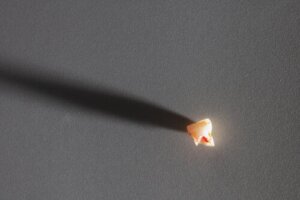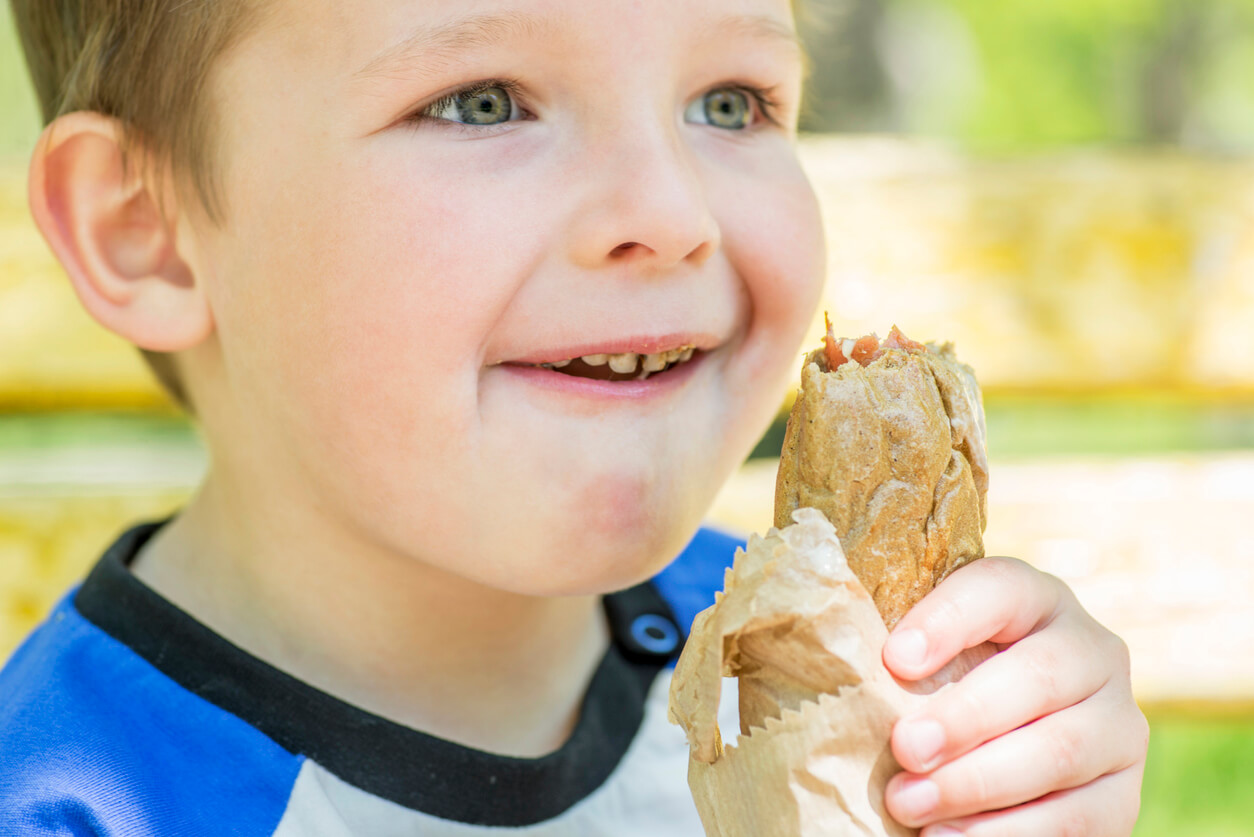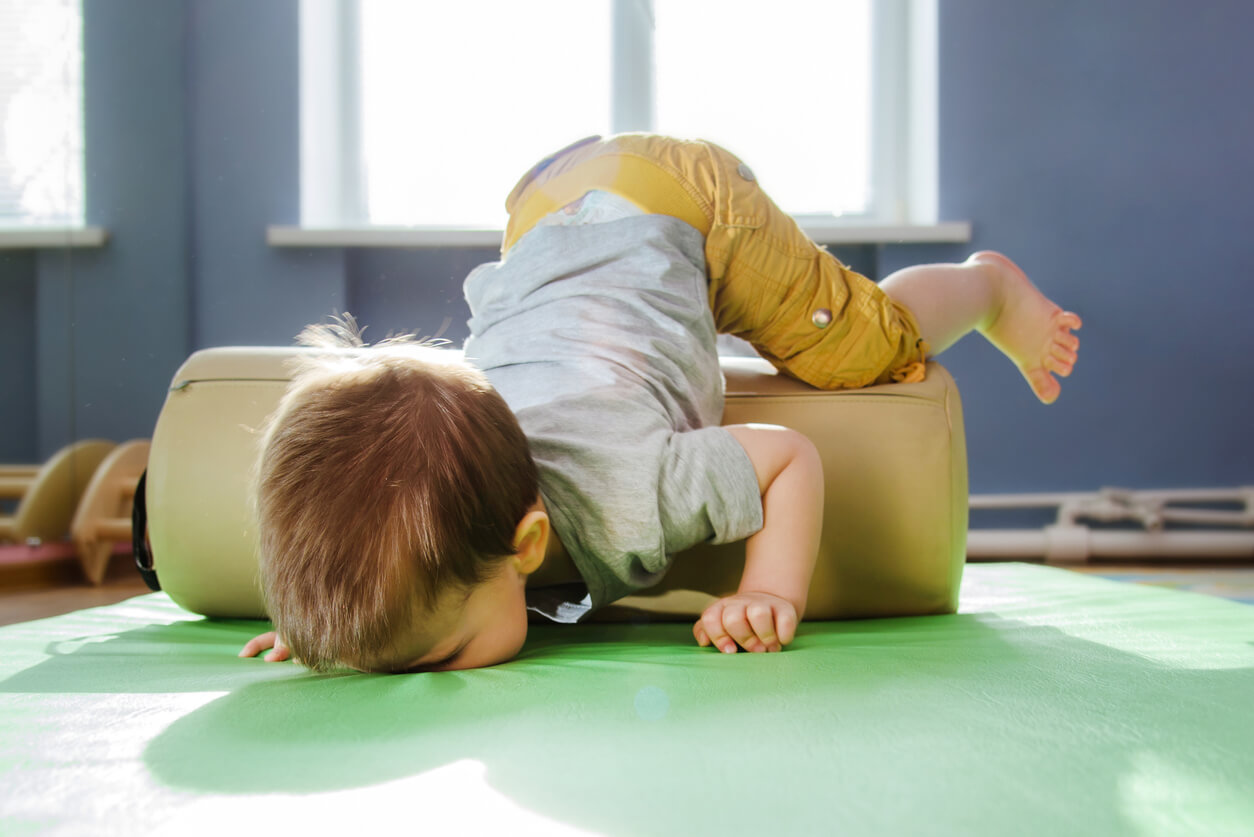Premature Loss of a Baby Tooth: Causes and Consequences

The loss of temporary teeth prior to the eruption of permanent teeth is a natural process that occurs in the mouths of all children. But the premature loss of a baby tooth can lead to problems in the mouth of the child.
If a temporary tooth comes out prematurely, the oral conditions are altered, the bite is modified, and the eruption of the definitive teeth is affected. There are several reasons that can cause this premature loss, and we’ll tell you about them here. We’ll also explain how to act if this happens to your child. Don’t miss it!
The importance of baby teeth
Although more and more parents are aware of the importance of taking care of their children’s primary teeth, the truth is that there’s still a myth in society that baby teeth are disposable and insignificant. For many, they’re temporary teeth that don’t require too much attention, as they’ll eventually fall out.
But this belief isn’t only incorrect, it’s also dangerous. Not taking care of children’s teeth can lead to the development of oral diseases that can affect the health and quality of life of the child.
There are 20 baby teeth and they play several important roles in the child’s mouth. As long as they’re healthy and present, they’ll allow the child to develop oral functions without problems. For example, they’ll contribute to the correct chewing of food, a fundamental act for nutrition, and will intervene in the phonation and pronunciation of words. Likewise, the presence of the temporary elements in the mouth will favor the development and growth of the maxillary bones. Baby teeth also serve to save the necessary space for permanent teeth.

When do baby teeth fall out?
The natural loss of baby teeth is a progressive process that begins around the age of 6 and ends around the age of 12. In any case, each child has their own growth rhythm, which explains why it may begin or end earlier or later.
The eruption of baby teeth occurs when the permanent tooth that will replace it is already developing inside the bone and is ready to erupt. The permanent tooth begins to reabsorb the root of the temporary tooth, which, losing support, moves until it falls out.
Incisors are usually the first baby teeth to fall out, and this milestone occurs between 6 and 8 years of age. This is followed by the first molars at around 9 to 10 years of age. Finally, the canines and second molars are lost between the ages of 10 and 13.
The possible causes of premature loss of a baby tooth
As mentioned above, there are several reasons that can cause the premature loss of a baby tooth. The most frequent causes are mentioned below:
- Cavities: This is the most common cause that leads to the deterioration of the dental elements. The advanced destruction of the teeth culminates with the indication of an extraction by the dentist or with the spontaneous breakage of the tooth and the expulsion of their fragments by the body.
- Trauma: Suffering a blow to the mouth can lead to the complete removal of the tooth from the oral cavity without the possibility of reimplantation. This treatment is to be avoided in baby teeth because of the risk of damaging the permanent teeth that are in formation.
- Infections: The presence of an infectious process in the dental roots, either as a result of cavities or trauma, can lead to its resorption and premature loss of the element.
- Nutritional problems: A diet deficient in calcium, magnesium, phosphorus, or vitamin D affects the correct development of the bone structure and can accelerate the loss of baby teeth.
- Malformations in the jaw or cleft palate: Both conditions affect the development of the dental root, which alters its support and can lead to premature loss of a baby tooth.
Consequences of premature loss of a baby tooth
When a baby tooth is lost prematurely, the child’s chewing, swallowing, and phonetic functions are altered. In some cases, the situation can also cause embarrassment or be a reason for teasing the child, which ends up affecting their social life and self-esteem.
At the oral level, the premature loss of a baby tooth is associated with the development of dental malocclusions, as the neighboring teeth lean in and move to occupy the remaining space. Thus, the bite is modified, the perimeter of the dental arch is shortened, and when the permanent tooth tries to erupt, it can no longer find its place. Consequently, it erupts in the wrong place, or causes crowding, diastemas, occlusion problems, and malpositions.

What to do if a baby tooth falls out prematurely?
Although it’s best to avoid the premature loss of a baby tooth, there are situations that can’t be prevented. Under these circumstances, it’s essential to consult a pediatric dentist to evaluate the specific case of the child. With a thorough physical, radiographic, and photographic examination, the dentist will be able to determine the time remaining for the eruption of the definitive tooth and suggest the best therapy.
Unless the definitive tooth is ready to erupt, the dentist may recommend placing a space maintainer in the mouth. This is an appliance that prevents neighboring teeth from moving and taking the place of the lost tooth. You should know that this appliance doesn’t interfere with the eruption of the other teeth or impair the development or growth of the jaws.
Space maintainers can be fixed or removable and are made of acrylic or metal. The choice of each one will depend on the number of missing elements and the particularities of the child. The dentist will determine the best option for each case.
This procedure prevents the malocclusion problems that usually result from the premature loss of a baby tooth.
The importance of taking care of baby teeth
As we’ve already mentioned, the health of baby teeth is fundamental for the correct development of children. For this reason, paying special attention to oral care from an early age is the best way to prevent oral problems.
To maintain a healthy mouth, it’s crucial to brush your child’s teeth, gums, and tongue three times a day with an age-appropriate amount of fluoride toothpaste. It’s also important to eat a nutritious diet that’s rich in minerals and vitamins and low in simple or refined sugars.
Visiting a pediatric dentist regularly, at least twice a year from the child’s first year of life, is crucial for oral health care. The professional follows the growth of the mouth and the eruption of teeth, and can detect and solve any problems in time. Also, they also help parents know what the best way to take care of their little one’s mouth is.
With these healthy habits, avoiding the premature loss of a baby tooth is possible. These simple measures will help your child to have a healthy smile and go through the replacement of their teeth in a natural way and at the right time.
The loss of temporary teeth prior to the eruption of permanent teeth is a natural process that occurs in the mouths of all children. But the premature loss of a baby tooth can lead to problems in the mouth of the child.
If a temporary tooth comes out prematurely, the oral conditions are altered, the bite is modified, and the eruption of the definitive teeth is affected. There are several reasons that can cause this premature loss, and we’ll tell you about them here. We’ll also explain how to act if this happens to your child. Don’t miss it!
The importance of baby teeth
Although more and more parents are aware of the importance of taking care of their children’s primary teeth, the truth is that there’s still a myth in society that baby teeth are disposable and insignificant. For many, they’re temporary teeth that don’t require too much attention, as they’ll eventually fall out.
But this belief isn’t only incorrect, it’s also dangerous. Not taking care of children’s teeth can lead to the development of oral diseases that can affect the health and quality of life of the child.
There are 20 baby teeth and they play several important roles in the child’s mouth. As long as they’re healthy and present, they’ll allow the child to develop oral functions without problems. For example, they’ll contribute to the correct chewing of food, a fundamental act for nutrition, and will intervene in the phonation and pronunciation of words. Likewise, the presence of the temporary elements in the mouth will favor the development and growth of the maxillary bones. Baby teeth also serve to save the necessary space for permanent teeth.

When do baby teeth fall out?
The natural loss of baby teeth is a progressive process that begins around the age of 6 and ends around the age of 12. In any case, each child has their own growth rhythm, which explains why it may begin or end earlier or later.
The eruption of baby teeth occurs when the permanent tooth that will replace it is already developing inside the bone and is ready to erupt. The permanent tooth begins to reabsorb the root of the temporary tooth, which, losing support, moves until it falls out.
Incisors are usually the first baby teeth to fall out, and this milestone occurs between 6 and 8 years of age. This is followed by the first molars at around 9 to 10 years of age. Finally, the canines and second molars are lost between the ages of 10 and 13.
The possible causes of premature loss of a baby tooth
As mentioned above, there are several reasons that can cause the premature loss of a baby tooth. The most frequent causes are mentioned below:
- Cavities: This is the most common cause that leads to the deterioration of the dental elements. The advanced destruction of the teeth culminates with the indication of an extraction by the dentist or with the spontaneous breakage of the tooth and the expulsion of their fragments by the body.
- Trauma: Suffering a blow to the mouth can lead to the complete removal of the tooth from the oral cavity without the possibility of reimplantation. This treatment is to be avoided in baby teeth because of the risk of damaging the permanent teeth that are in formation.
- Infections: The presence of an infectious process in the dental roots, either as a result of cavities or trauma, can lead to its resorption and premature loss of the element.
- Nutritional problems: A diet deficient in calcium, magnesium, phosphorus, or vitamin D affects the correct development of the bone structure and can accelerate the loss of baby teeth.
- Malformations in the jaw or cleft palate: Both conditions affect the development of the dental root, which alters its support and can lead to premature loss of a baby tooth.
Consequences of premature loss of a baby tooth
When a baby tooth is lost prematurely, the child’s chewing, swallowing, and phonetic functions are altered. In some cases, the situation can also cause embarrassment or be a reason for teasing the child, which ends up affecting their social life and self-esteem.
At the oral level, the premature loss of a baby tooth is associated with the development of dental malocclusions, as the neighboring teeth lean in and move to occupy the remaining space. Thus, the bite is modified, the perimeter of the dental arch is shortened, and when the permanent tooth tries to erupt, it can no longer find its place. Consequently, it erupts in the wrong place, or causes crowding, diastemas, occlusion problems, and malpositions.

What to do if a baby tooth falls out prematurely?
Although it’s best to avoid the premature loss of a baby tooth, there are situations that can’t be prevented. Under these circumstances, it’s essential to consult a pediatric dentist to evaluate the specific case of the child. With a thorough physical, radiographic, and photographic examination, the dentist will be able to determine the time remaining for the eruption of the definitive tooth and suggest the best therapy.
Unless the definitive tooth is ready to erupt, the dentist may recommend placing a space maintainer in the mouth. This is an appliance that prevents neighboring teeth from moving and taking the place of the lost tooth. You should know that this appliance doesn’t interfere with the eruption of the other teeth or impair the development or growth of the jaws.
Space maintainers can be fixed or removable and are made of acrylic or metal. The choice of each one will depend on the number of missing elements and the particularities of the child. The dentist will determine the best option for each case.
This procedure prevents the malocclusion problems that usually result from the premature loss of a baby tooth.
The importance of taking care of baby teeth
As we’ve already mentioned, the health of baby teeth is fundamental for the correct development of children. For this reason, paying special attention to oral care from an early age is the best way to prevent oral problems.
To maintain a healthy mouth, it’s crucial to brush your child’s teeth, gums, and tongue three times a day with an age-appropriate amount of fluoride toothpaste. It’s also important to eat a nutritious diet that’s rich in minerals and vitamins and low in simple or refined sugars.
Visiting a pediatric dentist regularly, at least twice a year from the child’s first year of life, is crucial for oral health care. The professional follows the growth of the mouth and the eruption of teeth, and can detect and solve any problems in time. Also, they also help parents know what the best way to take care of their little one’s mouth is.
With these healthy habits, avoiding the premature loss of a baby tooth is possible. These simple measures will help your child to have a healthy smile and go through the replacement of their teeth in a natural way and at the right time.
All cited sources were thoroughly reviewed by our team to ensure their quality, reliability, currency, and validity. The bibliography of this article was considered reliable and of academic or scientific accuracy.
- Zúñiga Bernabé, S. M. (2017). Prevalencia de pérdida prematura de dientes temporales en niños 3-9 años, Clínica UCSG A-2017.
- Faerrari, N. V., Toledo, N. J., Godoy, A. C., & Chirife, M. T. (2013). Pérdida prematura de dientes temporarios en niños que acudieron a un hospital público de la Ciudad de Luque-Paraguay. Revista de Odontopediatría Latinoamericana, 3(2), 10-10.
- Mónica, O., Sol, G., Margarita, F., & Mata, M. (2009). Pérdida prematura de dientes temporales en pacientes de 5 a 8 años de edad asistidos en la Clínica de Odontopediatria de la Universidad Gran Mariscal de Ayacucho, 2004-2005. Revista Latinoamericana de Ortodoncia y Odontopediatria.
- Ramirez Vargas, R. A., & Vera Jauregui, S. A. (2019). Perdida prematura de dientes temporales en niños de 4 a 12 años (Bachelor’s thesis, Universidad de Guayaquil. Facultad Piloto de Odontología).
- Zambrano Parrales, L. A. (2012). Pérdida prematura de dientes primarios en niños de 5 a 8 años y su terapéutica (Bachelor’s thesis, Universidad de Guayaquil. Facultad Piloto de Odontología).
- Espín Flores, M. F. (2018). Pérdida prematura de dientes temporales en niños de 3 a 8 años que acuden a la Clínica de Odontopediatría de la Facultad de Odontología de la Universidad Central del Ecuador (Bachelor’s thesis, Quito: UCE).
- Cruz Montero, V. C. (2017). Efecto de la pérdida prematura de los molares temporarios (Bachelor’s thesis, Universidad de Guayaquil. Facultad Piloto de Odontología).
- Suquinagua Segovia, P. A. (2017). Tratamiento con mantenedor de espacio por la Pérdida temprana de los dientes primarios (Bachelor’s thesis, Universidad de Guayaquil, Facultad Piloto de Odontologìa).
- Echevarría-Mendieta, S., Romero-Velarde, M., & Villena–Sarmiento, R. (2019). Mantenedor de Espacio Estético-Funcional en Odontopediatría: Reporte de caso. KIRU [Internet], 16(2), 81-91.
- Cardoso, M. L., Escobar, I. M., Burlli, D. Y., Díaz, N. G., & Galiana, A. V. (2019). Mantenedor de espacio removible: planificación del tratamiento y seguimiento de un caso clínico. Revista de la Facultad de Odontología, 12(1), 40-46.
- Andrade Cerón, K. R. (2020). Mantenedores de espacio fijo y removibles en pacientes Odontopediátricos sometidos a extracciones múltiples (Bachelor’s thesis, Universidad de Guayaquil. Facultad Piloto de Odontología).
This text is provided for informational purposes only and does not replace consultation with a professional. If in doubt, consult your specialist.








